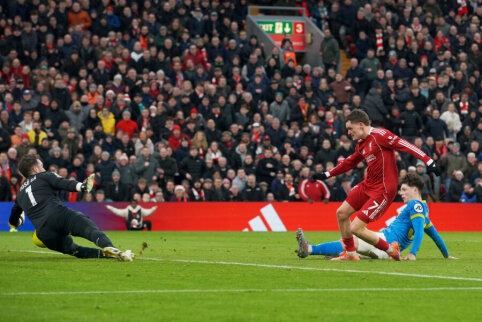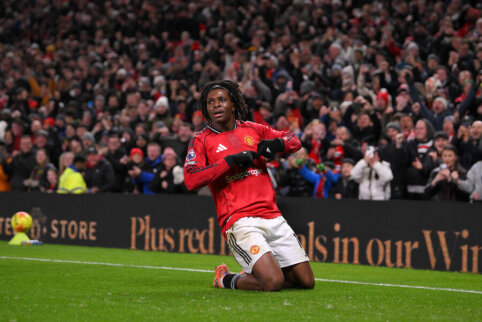
On June 10th, a month-long football madness began, taking over all of Europe. Millions of football fans are watching the European Football Championship battles in stadiums and in front of their TV screens. This celebration attracts football enthusiasts from all over Europe and is even very popular in other continents, writes football coach working with children and youth, Tadas Vilkevičius.
Every day, in the depths of the internet, in the press, or in other media outlets, one can find a wealth of information about past or future championship matches. Game analyses, predictions about team line-ups, tactical setups, match outcomes - this is what not only the personnel of the national teams participating in the European Championship are currently living, but also all football fans, of which there is no shortage even in Lithuania.
Some football fans discuss the low goal-scoring rates in the championship, while others criticize the declining level of play. Others point out the goals scored at the end of matches. For some time now, not only among football fans, but also among specialists in this game, there has been a prevailing opinion that a corner is half a goal. Often when watching matches, people in the stadium celebrate a corner kick as if their team had scored a goal. However, numbers never lie...
With great interest from the Lithuanian public in the European Championship (despite our national team not participating), the coach wants to share statistics that are presented after each round of the championship. This information can help football enthusiasts better understand the sport and prove that some facts circulating in the football world are simply myths.
Meanwhile, the statistics of goals scored from corner kicks and analysis can help coaches evaluate the change in gameplay, identify trends, and aid in the training process.
EURO 2016 STATISTICS AFTER THE SECOND ROUND:
In the second round of the European Championship, when compared to the first, we saw a return of goals scored after 3 or more ball touches, a comeback in matches from being behind, and an increase in the percentage of goals scored from corner situations and penalty kicks. There was also an increase in successful passes from the edge of the box and penalty box area. However, there was a decrease in goals scored from outside the penalty area, from penalty kicks, and in the percentage of successful passes from outside the box and the central area.
Total goals: 47 (after the first round - 22)
Average goals per game: 1.96 (after the first round - 1.83)
Own goals: 2 (after the first round - 1)
Penalty goals: 4 (after the first round - 1)
Looking at the goals scored in the EURO 2016, it can be said that it is so far disappointingly low. The average goals per game are just 1.96, while in the previous European Championships in 2004 and 2008, the goal average was 2.48, and in 2012 - 2.45 goals per game. This is undoubtedly mostly influenced by the changed championship system. Now theoretically, a team can become European champion without scoring a single goal in the game (3 goalless draws and 4 won penalty shootouts). Goals are the beauty of football, and fans demand more and more of them, so UEFA may have a serious puzzle if the goal-scoring efficiency does not increase in the championship.
CORNER KICKS:
Total corner kicks: 226 (after the first round - 106)
Average corner kicks per game: 9.42 (after the first round - 8.83)
Goals scored after a corner situation: 3 (after the first round - 1)
Goals scored after a corner situation percentage: 1.33% (after the first round - 0.94%)
Percentage of all goals scored in the championship after a corner kick: 7.32% (after the first round 5%)
In the football world, especially among enthusiasts, there has been a long-standing belief that a corner kick is a dangerous situation. Not at all! Not in modern football! Statistical data show that so far in the championship, out of 226 corner kicks, only 3 goals were scored after those standard situations (the goals were scored by Switzerland (2 times) and Slovakia). Pay attention that often high-level teams, when defending from a corner situation, no longer leave players near the goalposts. This is because high-level coaches, knowing this statistics, instruct their players to position themselves near the goal in a way that they could quickly counterattack if necessary.
PENALTY KICKS:
Goals scored after direct penalty kicks: 3 (7.32% of all goals scored) (after the first round - 2 (10%)
Goals scored after indirect penalty kicks: 2 (4.88% of all goals scored) (after the first round - 1 (5%)
Similar facts about penalty kicks are revealed as in corner situations. How many players can accurately score penalty kicks? G. Bale, C. Ronaldo, L. Messi? Even the penalty kick statistics of these players would not be disappointing. Therefore, neither goalkeepers, nor team coaches, nor especially enthusiasts should fear penalty kicks, as the numbers of goals scored from these standard situations are also quite modest.
NUMBER OF BALL TOUCHES:
Goals scored with 1 touch: 27 (65.85% of all goals scored) (after the first round - 15 (75%)
Goals scored with 2 touches: 8 (19.51% of all goals scored) (after the first round - 5 (25%)
Goals scored with 3 touches: 2 (4.88% of all goals scored) (no goals scored in the first round)
Goals scored with 4 touches: 2 (4.88% of all goals scored) (no goals scored in the first round)
Goals scored with 5 or more touches: 2 (4.88% of all goals scored) (no goals scored in the first round)
Football fans often highlight and remember fantastic goals from distance, deceptive moves, and other show elements, but looking at the statistics, one should ask: Which is more useful? A forward who can score a goal with one touch or, in the worst case, two touches? Or one who can dribble the ball well, perform a variety of deceptive moves. In modern football, everything happens incredibly fast, and the game gets faster. Looking at the statistics, one can confidently say that the more a player touches the ball, the fewer goals are scored. This trend, according to the available statistical data, has been dominant in high-level football for over 14 years (since the 2002 World Cup).
GOALS SCORED FROM AND OUTSIDE THE PENALTY AREA:
Goals scored from the penalty area: 35 (85.37% of all goals scored) (after the first round - 16 (80%)
Goals scored from outside the penalty area: 6 (14.63% of all goals scored) (after the first round - 4 (20%)
Another statistical indicator that should catch the eye of football enthusiasts. Many fans often hope for and admire long-range strikes, but when it comes to goals scored from close range, they often say: "Oh, they just scored a simple goal." I would suggest paying more attention to goals scored from the penalty area: how the attack was constructed, what actions the defending team took, and what led to the goal being scored. Quite similar and even greater numbers about goals scored from the penalty area have been documented in high-level competitions in studies conducted more than 30 years ago. Also, in my analysis of goals scored in the World Cup from 2002-2014 and European Championships from 2004-2012, the statistical data on goals scored show very similar results. Considering this, it can be stated that this trend, which has not changed for 30 years, will persist for a long time, and football fans seeking key moments when goals are scored should pay attention to the recommendations mentioned above.
ASSISTING PASSES:
Total successful passes: 34 (after the first round - 17)
Average successful passes per game: 1.42 (after the first round - 1.42)
Successful passes from the edge of the box: 15 (44.12% of all successful passes) (after the first round - 7 (41.18)
Successful passes from the penalty area: 9 (26.47% of all successful passes) (after the first round - 4 (23.53%)
Successful passes outside the penalty area, central area: 6 (17.65% of all successful passes) (after the first round - 4 (23.53)
Successful passes from the other side of the box: 4 (11.76% of all successful passes) (after the first round - 2 (11.76%)
These results are largely influenced by the fact that relatively weaker teams defend very compactly and leave very little space in the central zone of the pitch for opponents. Every modern, progressive coach knows the statistics I have presented about goals scored from the penalty area, so they structure their team's defensive actions in such a way that the most dangerous zones in the penalty box (the areas right in front of the goal) are covered. As a result, stronger teams can find and create space mostly on the edges of the penalty box, where they can often create a 1v1 situation. With individually stronger players, this tactic is very effective, as after beating the opponent's defender, attacking players have good chances to end up in the opponents' penalty box or make a quick pass from the edge.
GOALS SCORED WITH SPECIFIC BODY PARTS:
Goals scored with head: 11 (24.44% of all goals scored)
Goals scored with inner foot: 13 (28.89% of all goals scored)
Goals scored with a shot: 9 (20% of all goals scored)
Goals scored with inner thigh: 9 (20% of all goals scored)
Goals scored with other body parts: 3 (6.67% of all goals scored)
When looking at the statistics of this championship, the goal percentage achieved with a shot made using the inner thigh is very impressive. Comparing to other top-level championships, according to the available statistical data, from 2002 to 2014, this shooting technique has significantly increased the number of goals scored. Currently, as many goals are being scored with a shot as with a header! This is surprising because to execute this shot accurately, relatively more time is needed than when shooting with the head, a kick, or the inner foot. Let's see if this statistic will remain similar until the end of the championship.
TIME OF GOALS SCORED:
0-15 min. - 2 (4.26% of all goals scored)
16-30 min. - 2 (4.26% of all goals scored)
31-45 min. - 10 (21.28% of all goals scored)
46-60 min. - 10 (21.28% of all goals scored)
61-75 min. - 7 (14.89% of all goals scored)
76-90 min. - 10 (21.28% of all goals scored)
90+ - 6 (12.77% of all goals scored)
Fan concerns about the goal drought in the first half are not baseless. This is also reflected in the statistics. I would like to return to the championship system, which encourages teams to play as defensively as possible. In the first rounds, no one wanted to take risks. We'll see how it goes from here. Some teams in the third round have nowhere else to go, so there is hope for more goals. Many also discuss the abundance of late goals in matches, but one can both agree and disagree on that. The percentage of goals scored in the 76-90 min. range is exactly the same as in the 31-45 min. or 46-60 min. - 10%. Speaking of "Fergie time" (added time in matches, often referred to among football fans by the name of the famous Sir Alex Ferguson), the statistics are funnier. During this added time, which often determines the end of matches, as many as 6 goals were scored out of 47, which makes up quite a significant portion - 12.77%. It is worth mentioning that matches usually have 3 or 4 minutes of added time.
INTERESTING:
- The team that scored a goal in the first half won 7 times, played 4 draws, and lost only once
- In no game did both teams fail to score in the first half
- Only one team in this championship, after conceding the first goal, won the match
Tadas Vilkevičius























